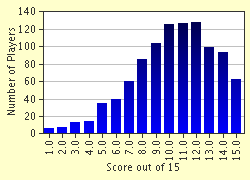Quiz Answer Key and Fun Facts
1. While talking about the human eye, what is the "pupil"?
2. The eye is very sensitive to bright light, while at the same time, it isn't very easy to see things in insufficient light. And so it is necessary to control the amount of light entering the eye through the pupil- it should be just about enough to see things clearly, but not so much as to damage the eye. What is the assembly of smooth (unstriated) muscle which controls the amount of light entering the eye called?
3. What is the scientific term for the "white of the eye", the part surrounding the eyeball?
4. Which part of the eye is analogous to the photographic plates which were once used (and still are, but to a lesser extent) in cameras?
5. The choroid is composed primarily of blood vessels.
6. What is the thick, transparent fluid that comprises about 2/3rd of the eye's volume?
7. What are the two types of light-sensitive cells which are contained in the retina?
8. What wavelengths of light can be detected by the human eye?
9. While the so-called "fine adjustment" for the formation of a clear image on the retina is done by the crystalline lens, it is not, by itself, capable of refracting the incident light to the degree required. Which part of the eye fulfills the function of the "coarse adjustment"?
10. The focal-length of the ___ is controlled by the ciliary muscles.
11. What is the "blind spot" of the eye?
12. The extra-ocular muscles (EOMs) are primarily responsible for the movements of the eye and its surroundings. How many EOMs are present in (or rather, outside) each eye, including the one that controls movement of the eyelid?
13. What do the Meibomian glands lining the edge of the eyelid, the lachrymal glands, and the goblet cells in the conjunctiva collectively produce?
14. For how much time does the impression or the sensation of an image remain on the retina of the eye (without staring at a constant stimulus)?
15. Even though this quiz is titled "Our EYES", all the questions preceding this one have focused entirely of the structure and functioning of just an individual eye by itself. Besides an increased field of vision, what is the other important advantage of possessing two, and not one, eye(s)?
Source: Author
achernar
This quiz was reviewed by FunTrivia editor
crisw before going online.
Any errors found in FunTrivia content are routinely corrected through our feedback system.

